HI5002 Finance for Business: Telstra & TPG Financial Analysis Report
VerifiedAdded on 2023/04/19
|18
|4645
|194
Report
AI Summary
This report analyzes the investment opportunities in the Australian market, focusing on Telstra Corporation Limited and TPG Telecom Limited from an overseas institutional investor's perspective. It evaluates the companies' business operations, profitability, liquidity, share price movements, and weighted average cost of capital (WACC). Ratio analysis, including operating margin, net margin, return on capital employed, current ratio, and quick ratio, are used to assess financial performance. Share price movements are compared against the All Ordinaries Index. Ultimately, the report recommends investing in Telstra Corporation Limited due to its superior financial performance and potential for maximized returns.
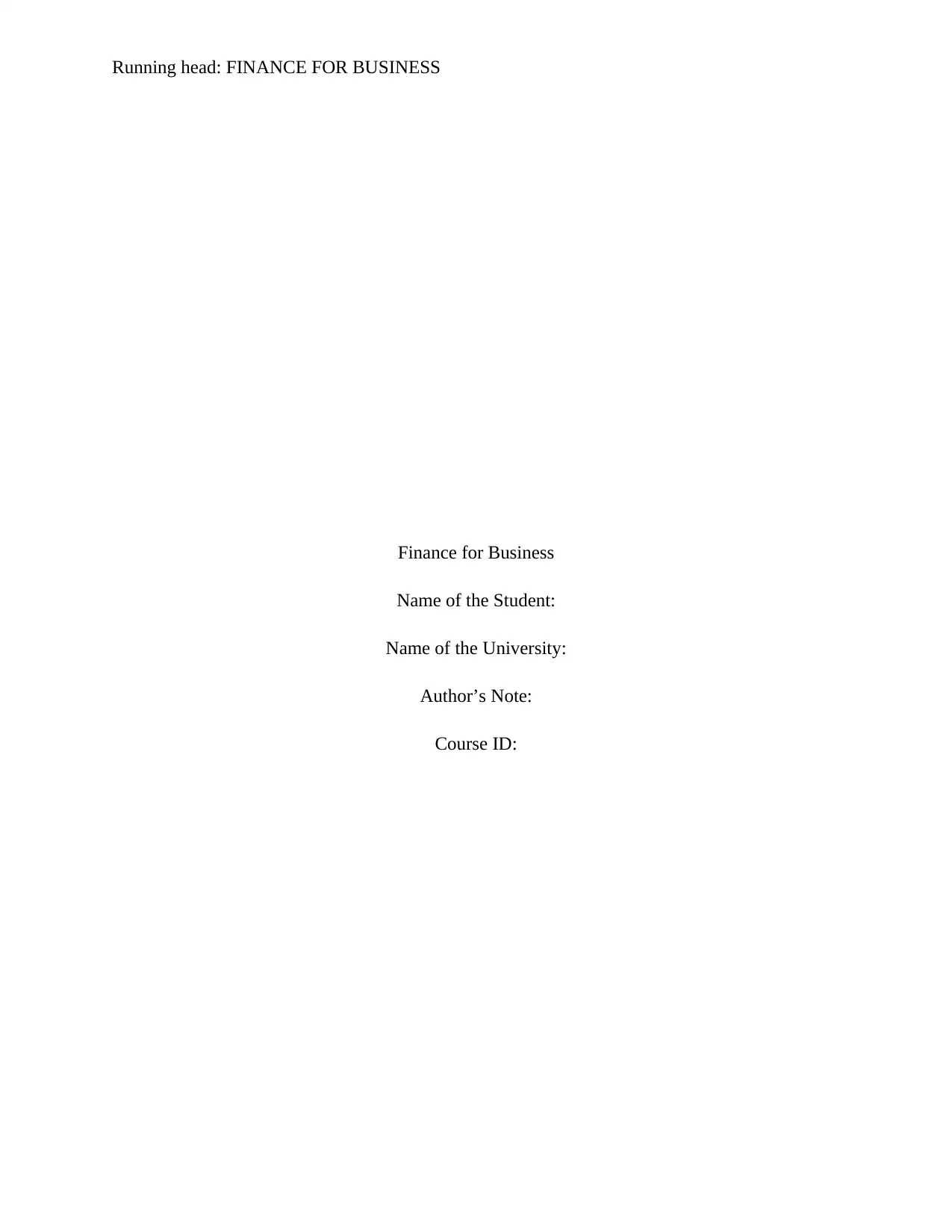
Running head: FINANCE FOR BUSINESS
Finance for Business
Name of the Student:
Name of the University:
Author’s Note:
Course ID:
Finance for Business
Name of the Student:
Name of the University:
Author’s Note:
Course ID:
Paraphrase This Document
Need a fresh take? Get an instant paraphrase of this document with our AI Paraphraser
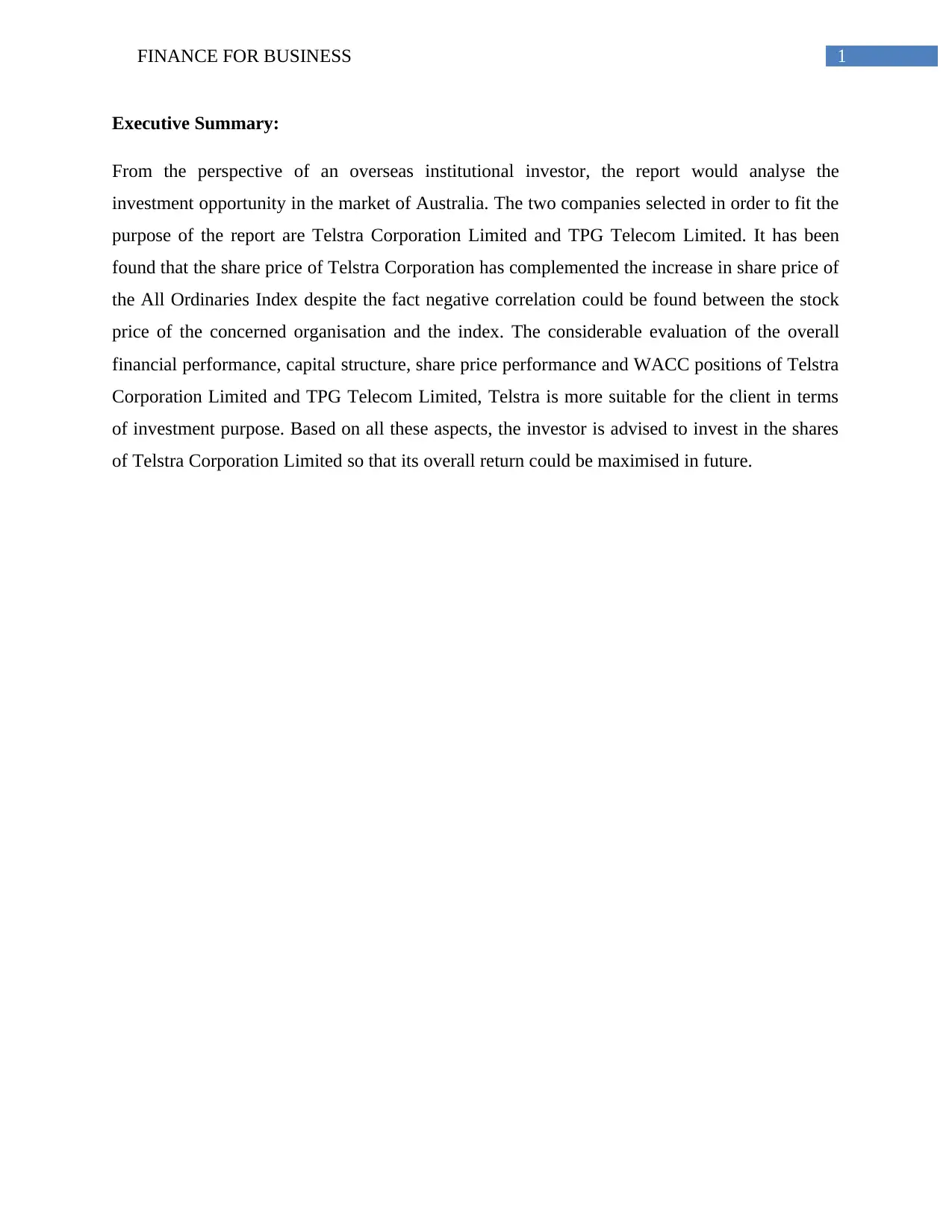
1FINANCE FOR BUSINESS
Executive Summary:
From the perspective of an overseas institutional investor, the report would analyse the
investment opportunity in the market of Australia. The two companies selected in order to fit the
purpose of the report are Telstra Corporation Limited and TPG Telecom Limited. It has been
found that the share price of Telstra Corporation has complemented the increase in share price of
the All Ordinaries Index despite the fact negative correlation could be found between the stock
price of the concerned organisation and the index. The considerable evaluation of the overall
financial performance, capital structure, share price performance and WACC positions of Telstra
Corporation Limited and TPG Telecom Limited, Telstra is more suitable for the client in terms
of investment purpose. Based on all these aspects, the investor is advised to invest in the shares
of Telstra Corporation Limited so that its overall return could be maximised in future.
Executive Summary:
From the perspective of an overseas institutional investor, the report would analyse the
investment opportunity in the market of Australia. The two companies selected in order to fit the
purpose of the report are Telstra Corporation Limited and TPG Telecom Limited. It has been
found that the share price of Telstra Corporation has complemented the increase in share price of
the All Ordinaries Index despite the fact negative correlation could be found between the stock
price of the concerned organisation and the index. The considerable evaluation of the overall
financial performance, capital structure, share price performance and WACC positions of Telstra
Corporation Limited and TPG Telecom Limited, Telstra is more suitable for the client in terms
of investment purpose. Based on all these aspects, the investor is advised to invest in the shares
of Telstra Corporation Limited so that its overall return could be maximised in future.

2FINANCE FOR BUSINESS
Table of Contents
Introduction:....................................................................................................................................3
1. Description of the chosen companies:.........................................................................................3
2. Calculation and comparison of selected performance ratios:......................................................4
3. Share price movement analysis:..................................................................................................8
4. Calculation and analysis of WACC:..........................................................................................10
5. Capital structure policy:.............................................................................................................12
6. Recommendation letter:.............................................................................................................13
Conclusion:....................................................................................................................................14
References:....................................................................................................................................16
Table of Contents
Introduction:....................................................................................................................................3
1. Description of the chosen companies:.........................................................................................3
2. Calculation and comparison of selected performance ratios:......................................................4
3. Share price movement analysis:..................................................................................................8
4. Calculation and analysis of WACC:..........................................................................................10
5. Capital structure policy:.............................................................................................................12
6. Recommendation letter:.............................................................................................................13
Conclusion:....................................................................................................................................14
References:....................................................................................................................................16
⊘ This is a preview!⊘
Do you want full access?
Subscribe today to unlock all pages.

Trusted by 1+ million students worldwide
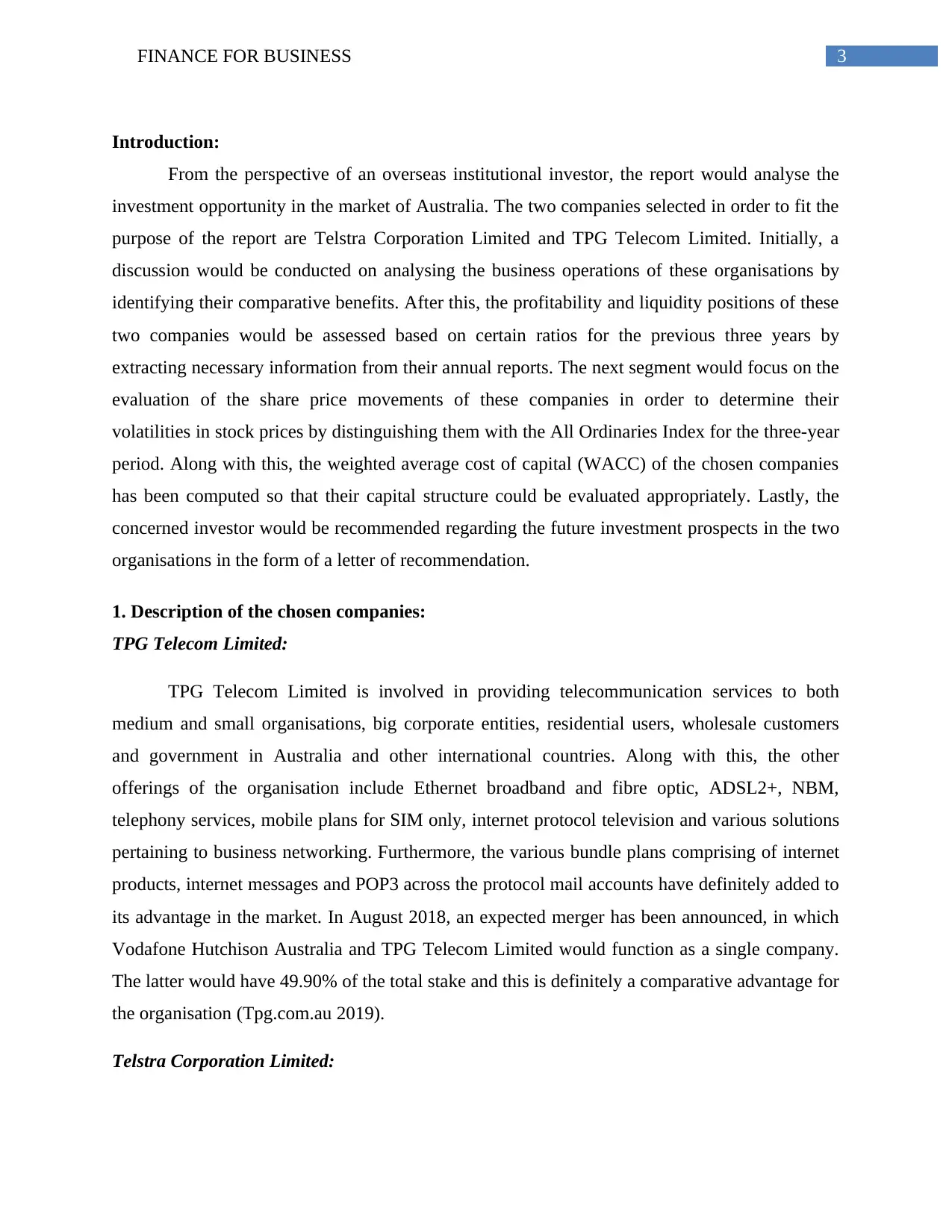
3FINANCE FOR BUSINESS
Introduction:
From the perspective of an overseas institutional investor, the report would analyse the
investment opportunity in the market of Australia. The two companies selected in order to fit the
purpose of the report are Telstra Corporation Limited and TPG Telecom Limited. Initially, a
discussion would be conducted on analysing the business operations of these organisations by
identifying their comparative benefits. After this, the profitability and liquidity positions of these
two companies would be assessed based on certain ratios for the previous three years by
extracting necessary information from their annual reports. The next segment would focus on the
evaluation of the share price movements of these companies in order to determine their
volatilities in stock prices by distinguishing them with the All Ordinaries Index for the three-year
period. Along with this, the weighted average cost of capital (WACC) of the chosen companies
has been computed so that their capital structure could be evaluated appropriately. Lastly, the
concerned investor would be recommended regarding the future investment prospects in the two
organisations in the form of a letter of recommendation.
1. Description of the chosen companies:
TPG Telecom Limited:
TPG Telecom Limited is involved in providing telecommunication services to both
medium and small organisations, big corporate entities, residential users, wholesale customers
and government in Australia and other international countries. Along with this, the other
offerings of the organisation include Ethernet broadband and fibre optic, ADSL2+, NBM,
telephony services, mobile plans for SIM only, internet protocol television and various solutions
pertaining to business networking. Furthermore, the various bundle plans comprising of internet
products, internet messages and POP3 across the protocol mail accounts have definitely added to
its advantage in the market. In August 2018, an expected merger has been announced, in which
Vodafone Hutchison Australia and TPG Telecom Limited would function as a single company.
The latter would have 49.90% of the total stake and this is definitely a comparative advantage for
the organisation (Tpg.com.au 2019).
Telstra Corporation Limited:
Introduction:
From the perspective of an overseas institutional investor, the report would analyse the
investment opportunity in the market of Australia. The two companies selected in order to fit the
purpose of the report are Telstra Corporation Limited and TPG Telecom Limited. Initially, a
discussion would be conducted on analysing the business operations of these organisations by
identifying their comparative benefits. After this, the profitability and liquidity positions of these
two companies would be assessed based on certain ratios for the previous three years by
extracting necessary information from their annual reports. The next segment would focus on the
evaluation of the share price movements of these companies in order to determine their
volatilities in stock prices by distinguishing them with the All Ordinaries Index for the three-year
period. Along with this, the weighted average cost of capital (WACC) of the chosen companies
has been computed so that their capital structure could be evaluated appropriately. Lastly, the
concerned investor would be recommended regarding the future investment prospects in the two
organisations in the form of a letter of recommendation.
1. Description of the chosen companies:
TPG Telecom Limited:
TPG Telecom Limited is involved in providing telecommunication services to both
medium and small organisations, big corporate entities, residential users, wholesale customers
and government in Australia and other international countries. Along with this, the other
offerings of the organisation include Ethernet broadband and fibre optic, ADSL2+, NBM,
telephony services, mobile plans for SIM only, internet protocol television and various solutions
pertaining to business networking. Furthermore, the various bundle plans comprising of internet
products, internet messages and POP3 across the protocol mail accounts have definitely added to
its advantage in the market. In August 2018, an expected merger has been announced, in which
Vodafone Hutchison Australia and TPG Telecom Limited would function as a single company.
The latter would have 49.90% of the total stake and this is definitely a comparative advantage for
the organisation (Tpg.com.au 2019).
Telstra Corporation Limited:
Paraphrase This Document
Need a fresh take? Get an instant paraphrase of this document with our AI Paraphraser
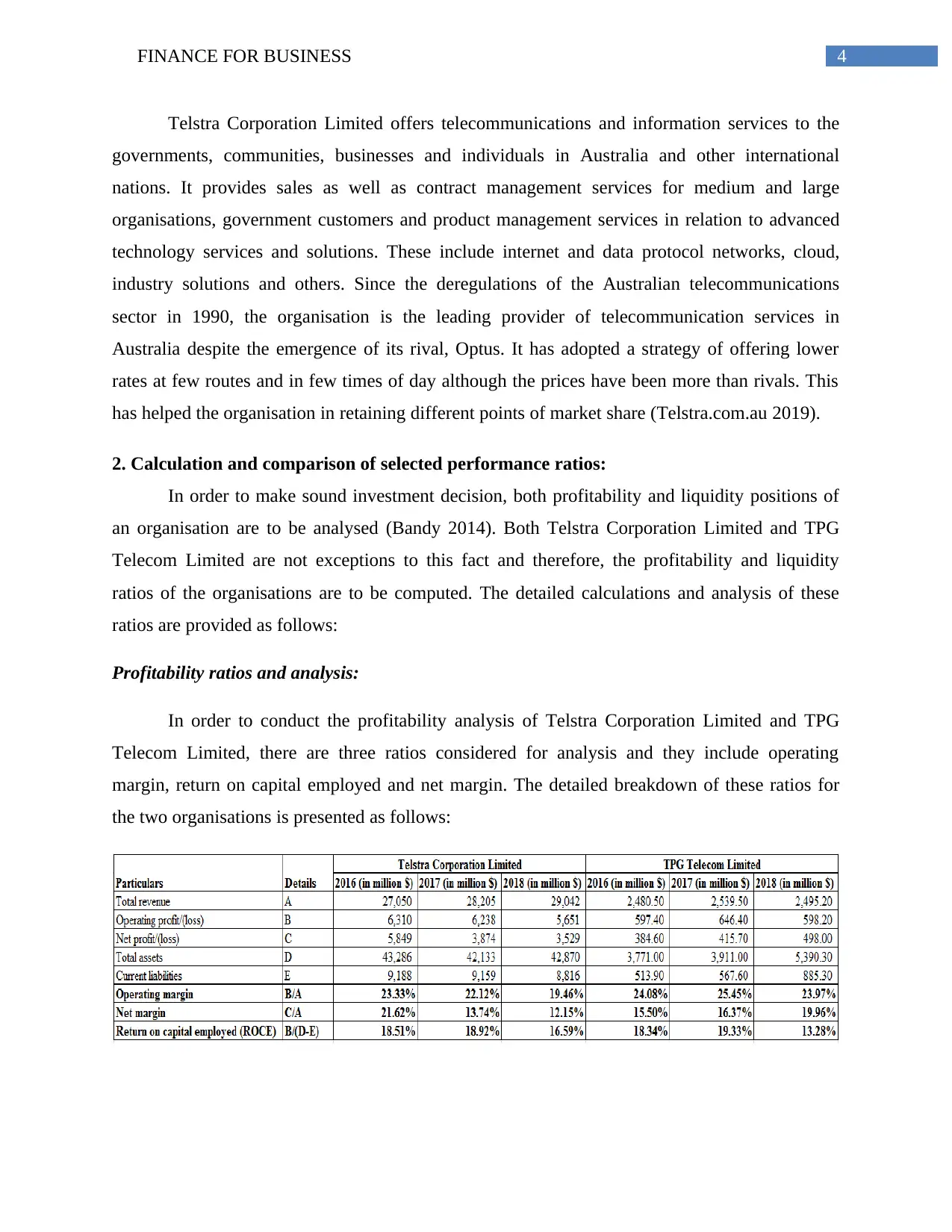
4FINANCE FOR BUSINESS
Telstra Corporation Limited offers telecommunications and information services to the
governments, communities, businesses and individuals in Australia and other international
nations. It provides sales as well as contract management services for medium and large
organisations, government customers and product management services in relation to advanced
technology services and solutions. These include internet and data protocol networks, cloud,
industry solutions and others. Since the deregulations of the Australian telecommunications
sector in 1990, the organisation is the leading provider of telecommunication services in
Australia despite the emergence of its rival, Optus. It has adopted a strategy of offering lower
rates at few routes and in few times of day although the prices have been more than rivals. This
has helped the organisation in retaining different points of market share (Telstra.com.au 2019).
2. Calculation and comparison of selected performance ratios:
In order to make sound investment decision, both profitability and liquidity positions of
an organisation are to be analysed (Bandy 2014). Both Telstra Corporation Limited and TPG
Telecom Limited are not exceptions to this fact and therefore, the profitability and liquidity
ratios of the organisations are to be computed. The detailed calculations and analysis of these
ratios are provided as follows:
Profitability ratios and analysis:
In order to conduct the profitability analysis of Telstra Corporation Limited and TPG
Telecom Limited, there are three ratios considered for analysis and they include operating
margin, return on capital employed and net margin. The detailed breakdown of these ratios for
the two organisations is presented as follows:
Telstra Corporation Limited offers telecommunications and information services to the
governments, communities, businesses and individuals in Australia and other international
nations. It provides sales as well as contract management services for medium and large
organisations, government customers and product management services in relation to advanced
technology services and solutions. These include internet and data protocol networks, cloud,
industry solutions and others. Since the deregulations of the Australian telecommunications
sector in 1990, the organisation is the leading provider of telecommunication services in
Australia despite the emergence of its rival, Optus. It has adopted a strategy of offering lower
rates at few routes and in few times of day although the prices have been more than rivals. This
has helped the organisation in retaining different points of market share (Telstra.com.au 2019).
2. Calculation and comparison of selected performance ratios:
In order to make sound investment decision, both profitability and liquidity positions of
an organisation are to be analysed (Bandy 2014). Both Telstra Corporation Limited and TPG
Telecom Limited are not exceptions to this fact and therefore, the profitability and liquidity
ratios of the organisations are to be computed. The detailed calculations and analysis of these
ratios are provided as follows:
Profitability ratios and analysis:
In order to conduct the profitability analysis of Telstra Corporation Limited and TPG
Telecom Limited, there are three ratios considered for analysis and they include operating
margin, return on capital employed and net margin. The detailed breakdown of these ratios for
the two organisations is presented as follows:
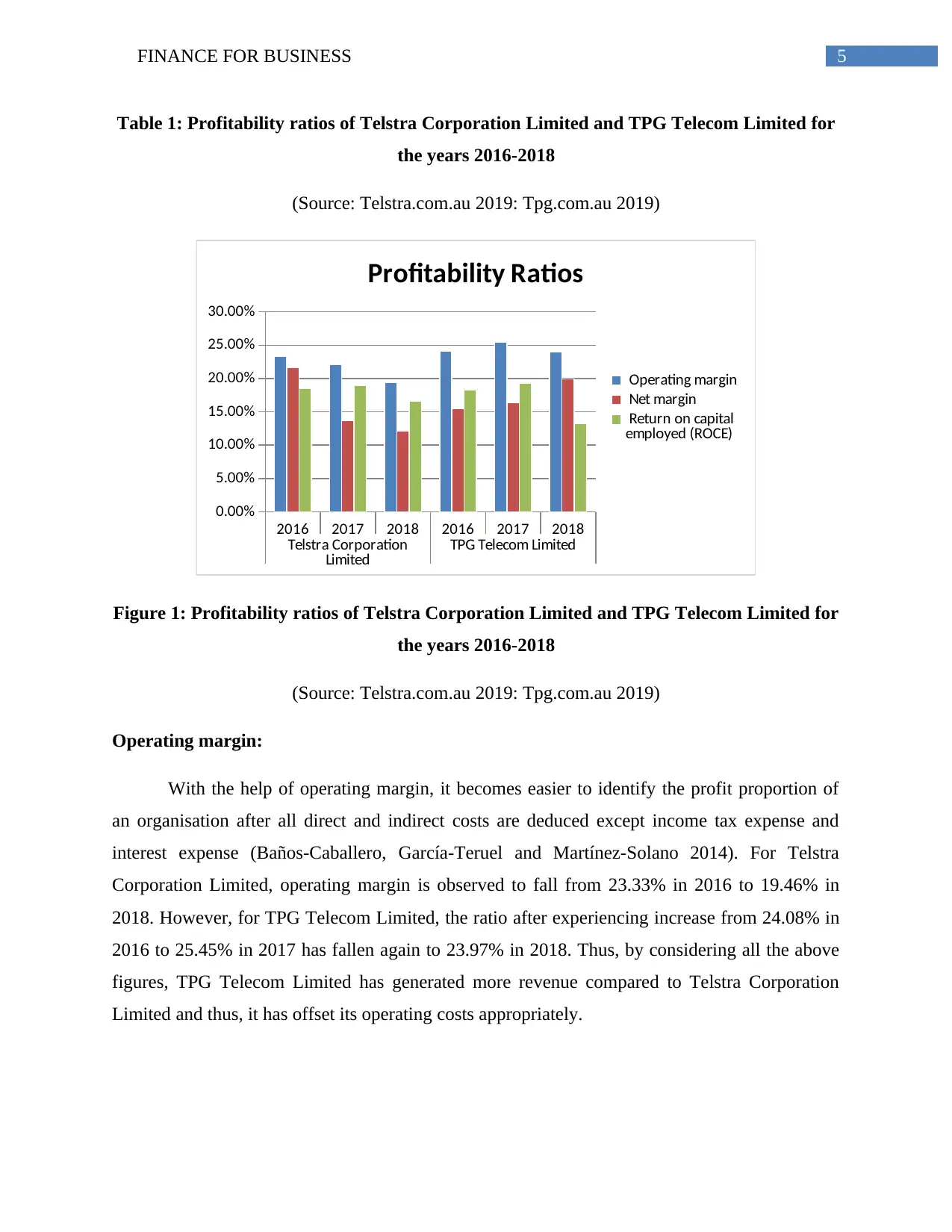
5FINANCE FOR BUSINESS
Table 1: Profitability ratios of Telstra Corporation Limited and TPG Telecom Limited for
the years 2016-2018
(Source: Telstra.com.au 2019: Tpg.com.au 2019)
2016 2017 2018 2016 2017 2018
Telstra Corporation
Limited TPG Telecom Limited
0.00%
5.00%
10.00%
15.00%
20.00%
25.00%
30.00%
Profitability Ratios
Operating margin
Net margin
Return on capital
employed (ROCE)
Figure 1: Profitability ratios of Telstra Corporation Limited and TPG Telecom Limited for
the years 2016-2018
(Source: Telstra.com.au 2019: Tpg.com.au 2019)
Operating margin:
With the help of operating margin, it becomes easier to identify the profit proportion of
an organisation after all direct and indirect costs are deduced except income tax expense and
interest expense (Baños-Caballero, García-Teruel and Martínez-Solano 2014). For Telstra
Corporation Limited, operating margin is observed to fall from 23.33% in 2016 to 19.46% in
2018. However, for TPG Telecom Limited, the ratio after experiencing increase from 24.08% in
2016 to 25.45% in 2017 has fallen again to 23.97% in 2018. Thus, by considering all the above
figures, TPG Telecom Limited has generated more revenue compared to Telstra Corporation
Limited and thus, it has offset its operating costs appropriately.
Table 1: Profitability ratios of Telstra Corporation Limited and TPG Telecom Limited for
the years 2016-2018
(Source: Telstra.com.au 2019: Tpg.com.au 2019)
2016 2017 2018 2016 2017 2018
Telstra Corporation
Limited TPG Telecom Limited
0.00%
5.00%
10.00%
15.00%
20.00%
25.00%
30.00%
Profitability Ratios
Operating margin
Net margin
Return on capital
employed (ROCE)
Figure 1: Profitability ratios of Telstra Corporation Limited and TPG Telecom Limited for
the years 2016-2018
(Source: Telstra.com.au 2019: Tpg.com.au 2019)
Operating margin:
With the help of operating margin, it becomes easier to identify the profit proportion of
an organisation after all direct and indirect costs are deduced except income tax expense and
interest expense (Baños-Caballero, García-Teruel and Martínez-Solano 2014). For Telstra
Corporation Limited, operating margin is observed to fall from 23.33% in 2016 to 19.46% in
2018. However, for TPG Telecom Limited, the ratio after experiencing increase from 24.08% in
2016 to 25.45% in 2017 has fallen again to 23.97% in 2018. Thus, by considering all the above
figures, TPG Telecom Limited has generated more revenue compared to Telstra Corporation
Limited and thus, it has offset its operating costs appropriately.
⊘ This is a preview!⊘
Do you want full access?
Subscribe today to unlock all pages.

Trusted by 1+ million students worldwide
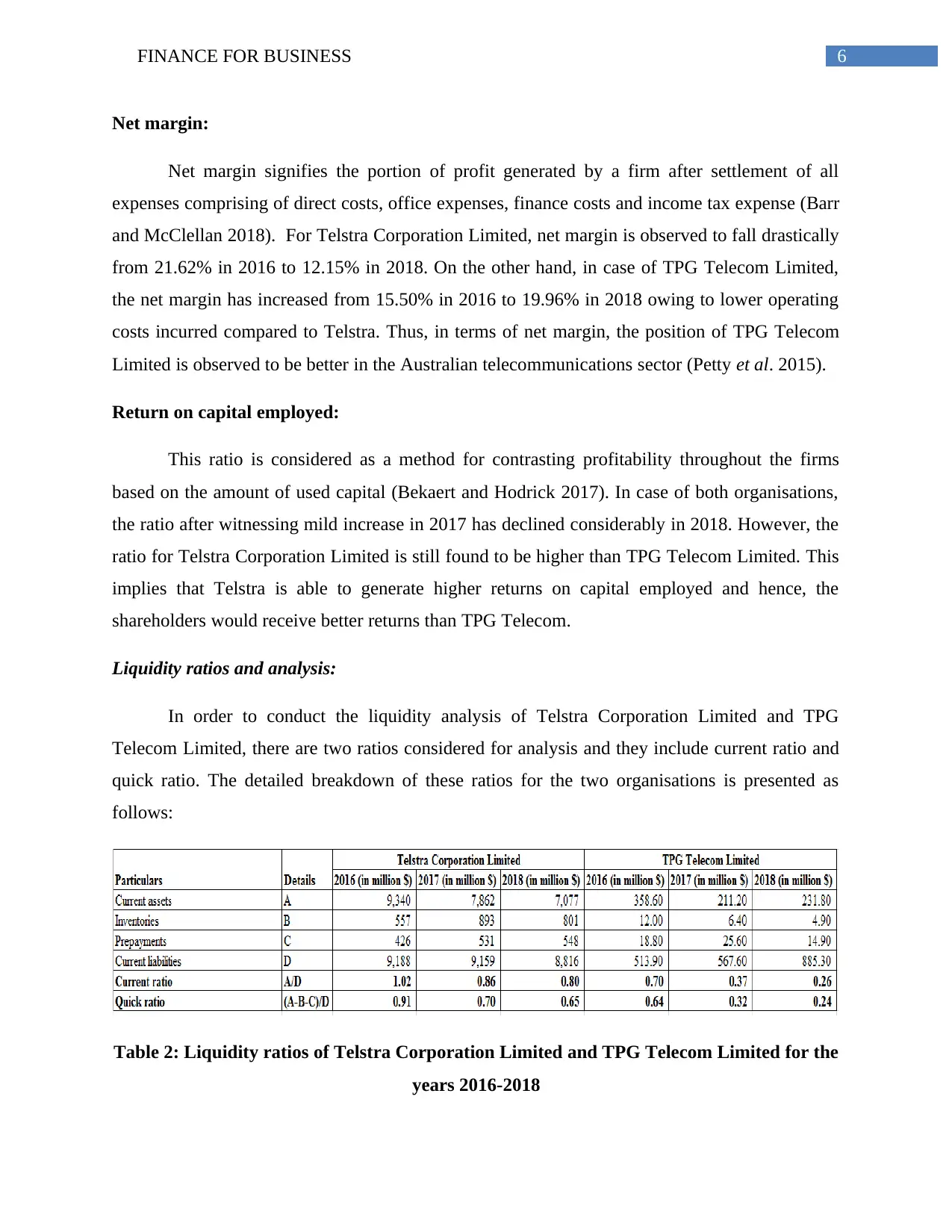
6FINANCE FOR BUSINESS
Net margin:
Net margin signifies the portion of profit generated by a firm after settlement of all
expenses comprising of direct costs, office expenses, finance costs and income tax expense (Barr
and McClellan 2018). For Telstra Corporation Limited, net margin is observed to fall drastically
from 21.62% in 2016 to 12.15% in 2018. On the other hand, in case of TPG Telecom Limited,
the net margin has increased from 15.50% in 2016 to 19.96% in 2018 owing to lower operating
costs incurred compared to Telstra. Thus, in terms of net margin, the position of TPG Telecom
Limited is observed to be better in the Australian telecommunications sector (Petty et al. 2015).
Return on capital employed:
This ratio is considered as a method for contrasting profitability throughout the firms
based on the amount of used capital (Bekaert and Hodrick 2017). In case of both organisations,
the ratio after witnessing mild increase in 2017 has declined considerably in 2018. However, the
ratio for Telstra Corporation Limited is still found to be higher than TPG Telecom Limited. This
implies that Telstra is able to generate higher returns on capital employed and hence, the
shareholders would receive better returns than TPG Telecom.
Liquidity ratios and analysis:
In order to conduct the liquidity analysis of Telstra Corporation Limited and TPG
Telecom Limited, there are two ratios considered for analysis and they include current ratio and
quick ratio. The detailed breakdown of these ratios for the two organisations is presented as
follows:
Table 2: Liquidity ratios of Telstra Corporation Limited and TPG Telecom Limited for the
years 2016-2018
Net margin:
Net margin signifies the portion of profit generated by a firm after settlement of all
expenses comprising of direct costs, office expenses, finance costs and income tax expense (Barr
and McClellan 2018). For Telstra Corporation Limited, net margin is observed to fall drastically
from 21.62% in 2016 to 12.15% in 2018. On the other hand, in case of TPG Telecom Limited,
the net margin has increased from 15.50% in 2016 to 19.96% in 2018 owing to lower operating
costs incurred compared to Telstra. Thus, in terms of net margin, the position of TPG Telecom
Limited is observed to be better in the Australian telecommunications sector (Petty et al. 2015).
Return on capital employed:
This ratio is considered as a method for contrasting profitability throughout the firms
based on the amount of used capital (Bekaert and Hodrick 2017). In case of both organisations,
the ratio after witnessing mild increase in 2017 has declined considerably in 2018. However, the
ratio for Telstra Corporation Limited is still found to be higher than TPG Telecom Limited. This
implies that Telstra is able to generate higher returns on capital employed and hence, the
shareholders would receive better returns than TPG Telecom.
Liquidity ratios and analysis:
In order to conduct the liquidity analysis of Telstra Corporation Limited and TPG
Telecom Limited, there are two ratios considered for analysis and they include current ratio and
quick ratio. The detailed breakdown of these ratios for the two organisations is presented as
follows:
Table 2: Liquidity ratios of Telstra Corporation Limited and TPG Telecom Limited for the
years 2016-2018
Paraphrase This Document
Need a fresh take? Get an instant paraphrase of this document with our AI Paraphraser
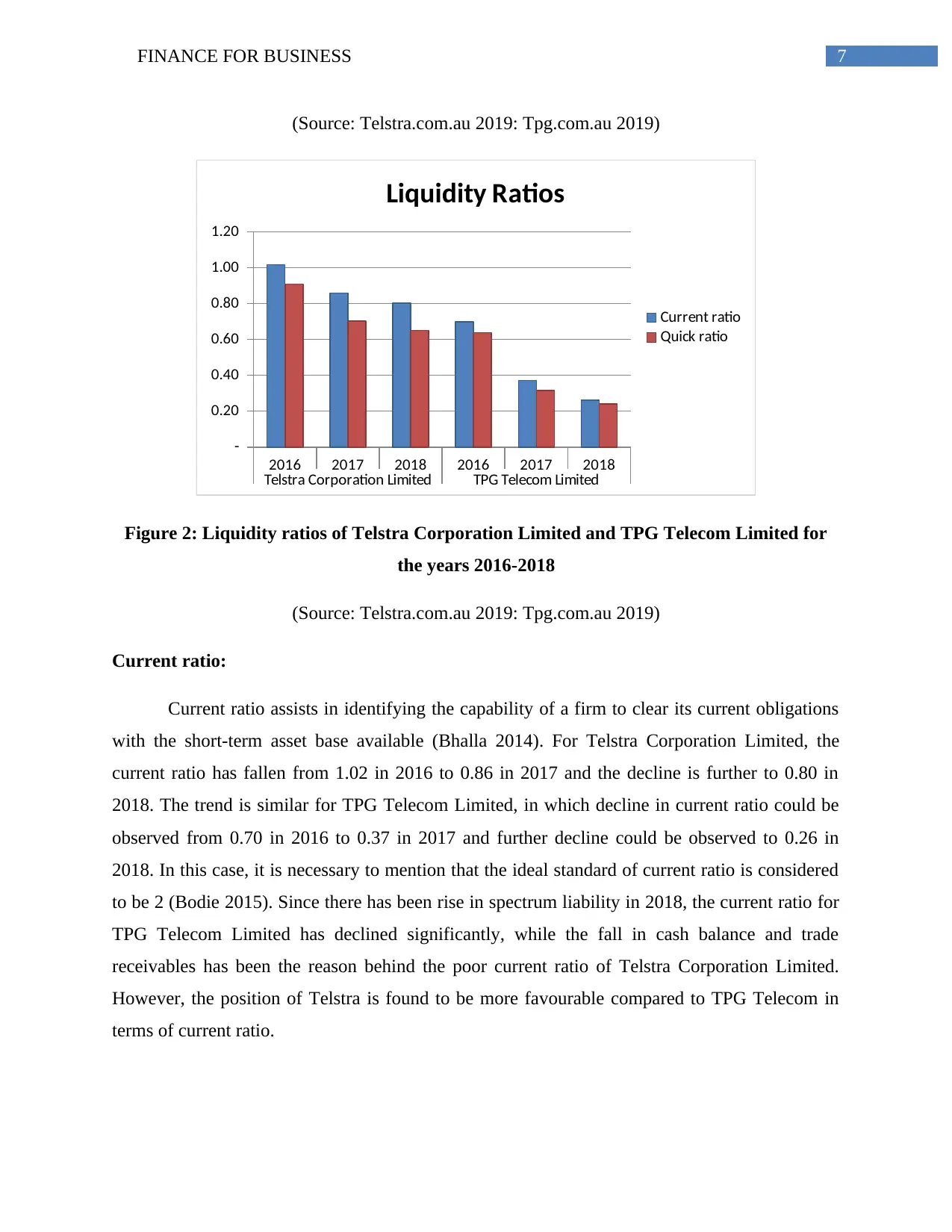
7FINANCE FOR BUSINESS
(Source: Telstra.com.au 2019: Tpg.com.au 2019)
2016 2017 2018 2016 2017 2018
Telstra Corporation Limited TPG Telecom Limited
-
0.20
0.40
0.60
0.80
1.00
1.20
Liquidity Ratios
Current ratio
Quick ratio
Figure 2: Liquidity ratios of Telstra Corporation Limited and TPG Telecom Limited for
the years 2016-2018
(Source: Telstra.com.au 2019: Tpg.com.au 2019)
Current ratio:
Current ratio assists in identifying the capability of a firm to clear its current obligations
with the short-term asset base available (Bhalla 2014). For Telstra Corporation Limited, the
current ratio has fallen from 1.02 in 2016 to 0.86 in 2017 and the decline is further to 0.80 in
2018. The trend is similar for TPG Telecom Limited, in which decline in current ratio could be
observed from 0.70 in 2016 to 0.37 in 2017 and further decline could be observed to 0.26 in
2018. In this case, it is necessary to mention that the ideal standard of current ratio is considered
to be 2 (Bodie 2015). Since there has been rise in spectrum liability in 2018, the current ratio for
TPG Telecom Limited has declined significantly, while the fall in cash balance and trade
receivables has been the reason behind the poor current ratio of Telstra Corporation Limited.
However, the position of Telstra is found to be more favourable compared to TPG Telecom in
terms of current ratio.
(Source: Telstra.com.au 2019: Tpg.com.au 2019)
2016 2017 2018 2016 2017 2018
Telstra Corporation Limited TPG Telecom Limited
-
0.20
0.40
0.60
0.80
1.00
1.20
Liquidity Ratios
Current ratio
Quick ratio
Figure 2: Liquidity ratios of Telstra Corporation Limited and TPG Telecom Limited for
the years 2016-2018
(Source: Telstra.com.au 2019: Tpg.com.au 2019)
Current ratio:
Current ratio assists in identifying the capability of a firm to clear its current obligations
with the short-term asset base available (Bhalla 2014). For Telstra Corporation Limited, the
current ratio has fallen from 1.02 in 2016 to 0.86 in 2017 and the decline is further to 0.80 in
2018. The trend is similar for TPG Telecom Limited, in which decline in current ratio could be
observed from 0.70 in 2016 to 0.37 in 2017 and further decline could be observed to 0.26 in
2018. In this case, it is necessary to mention that the ideal standard of current ratio is considered
to be 2 (Bodie 2015). Since there has been rise in spectrum liability in 2018, the current ratio for
TPG Telecom Limited has declined significantly, while the fall in cash balance and trade
receivables has been the reason behind the poor current ratio of Telstra Corporation Limited.
However, the position of Telstra is found to be more favourable compared to TPG Telecom in
terms of current ratio.
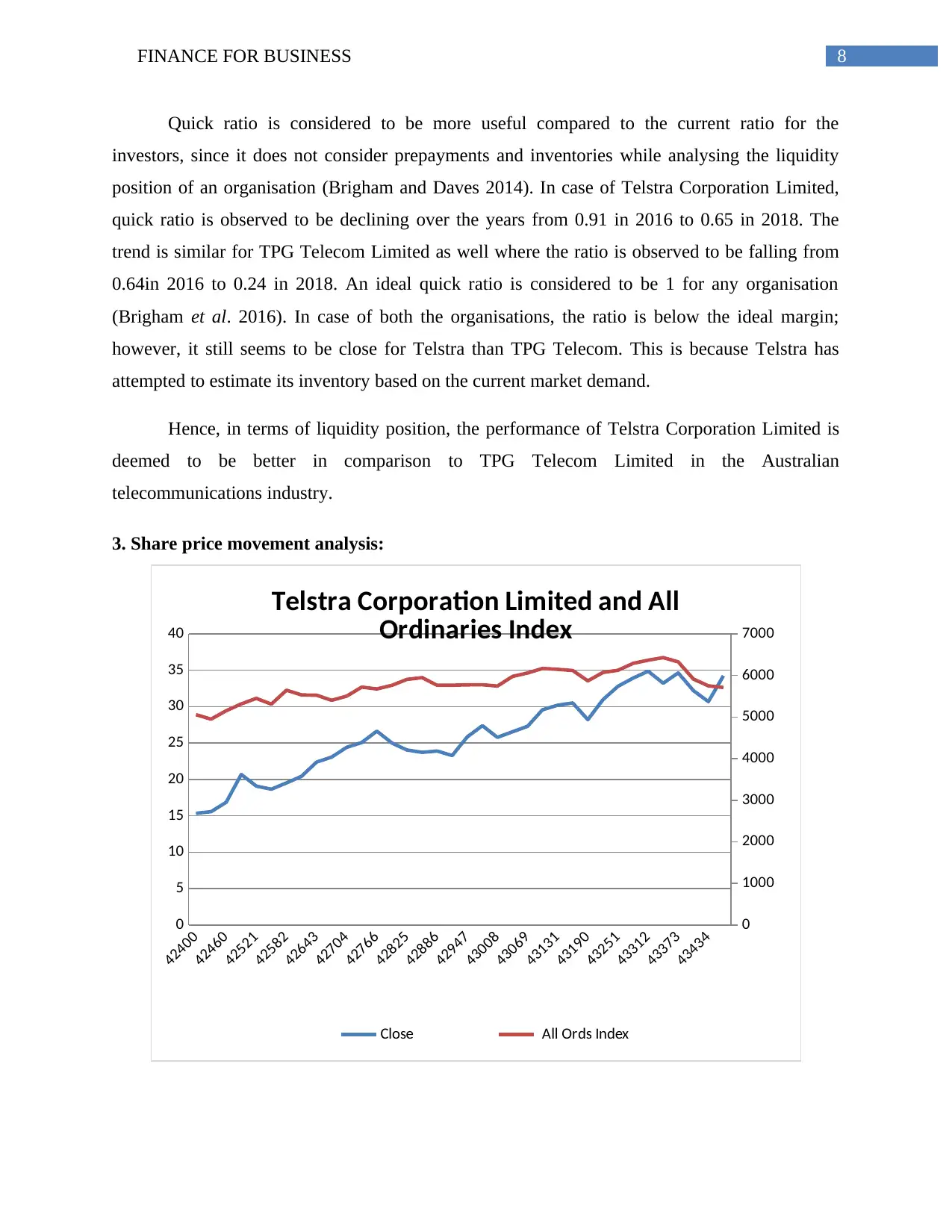
8FINANCE FOR BUSINESS
Quick ratio is considered to be more useful compared to the current ratio for the
investors, since it does not consider prepayments and inventories while analysing the liquidity
position of an organisation (Brigham and Daves 2014). In case of Telstra Corporation Limited,
quick ratio is observed to be declining over the years from 0.91 in 2016 to 0.65 in 2018. The
trend is similar for TPG Telecom Limited as well where the ratio is observed to be falling from
0.64in 2016 to 0.24 in 2018. An ideal quick ratio is considered to be 1 for any organisation
(Brigham et al. 2016). In case of both the organisations, the ratio is below the ideal margin;
however, it still seems to be close for Telstra than TPG Telecom. This is because Telstra has
attempted to estimate its inventory based on the current market demand.
Hence, in terms of liquidity position, the performance of Telstra Corporation Limited is
deemed to be better in comparison to TPG Telecom Limited in the Australian
telecommunications industry.
3. Share price movement analysis:
42400
42460
42521
42582
42643
42704
42766
42825
42886
42947
43008
43069
43131
43190
43251
43312
43373
43434
0
5
10
15
20
25
30
35
40
0
1000
2000
3000
4000
5000
6000
7000
Telstra Corporation Limited and All
Ordinaries Index
Close All Ords Index
Quick ratio is considered to be more useful compared to the current ratio for the
investors, since it does not consider prepayments and inventories while analysing the liquidity
position of an organisation (Brigham and Daves 2014). In case of Telstra Corporation Limited,
quick ratio is observed to be declining over the years from 0.91 in 2016 to 0.65 in 2018. The
trend is similar for TPG Telecom Limited as well where the ratio is observed to be falling from
0.64in 2016 to 0.24 in 2018. An ideal quick ratio is considered to be 1 for any organisation
(Brigham et al. 2016). In case of both the organisations, the ratio is below the ideal margin;
however, it still seems to be close for Telstra than TPG Telecom. This is because Telstra has
attempted to estimate its inventory based on the current market demand.
Hence, in terms of liquidity position, the performance of Telstra Corporation Limited is
deemed to be better in comparison to TPG Telecom Limited in the Australian
telecommunications industry.
3. Share price movement analysis:
42400
42460
42521
42582
42643
42704
42766
42825
42886
42947
43008
43069
43131
43190
43251
43312
43373
43434
0
5
10
15
20
25
30
35
40
0
1000
2000
3000
4000
5000
6000
7000
Telstra Corporation Limited and All
Ordinaries Index
Close All Ords Index
⊘ This is a preview!⊘
Do you want full access?
Subscribe today to unlock all pages.

Trusted by 1+ million students worldwide
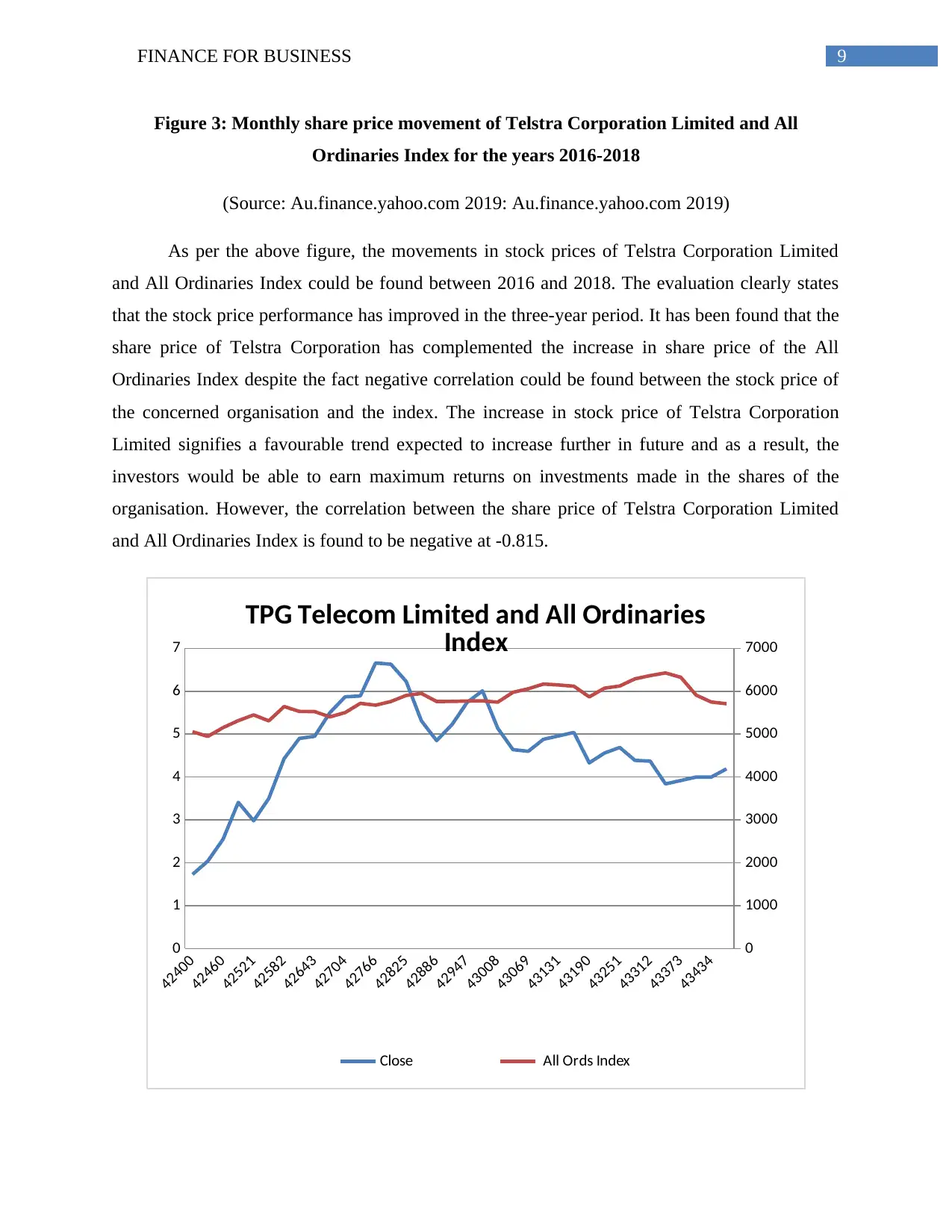
9FINANCE FOR BUSINESS
Figure 3: Monthly share price movement of Telstra Corporation Limited and All
Ordinaries Index for the years 2016-2018
(Source: Au.finance.yahoo.com 2019: Au.finance.yahoo.com 2019)
As per the above figure, the movements in stock prices of Telstra Corporation Limited
and All Ordinaries Index could be found between 2016 and 2018. The evaluation clearly states
that the stock price performance has improved in the three-year period. It has been found that the
share price of Telstra Corporation has complemented the increase in share price of the All
Ordinaries Index despite the fact negative correlation could be found between the stock price of
the concerned organisation and the index. The increase in stock price of Telstra Corporation
Limited signifies a favourable trend expected to increase further in future and as a result, the
investors would be able to earn maximum returns on investments made in the shares of the
organisation. However, the correlation between the share price of Telstra Corporation Limited
and All Ordinaries Index is found to be negative at -0.815.
42400
42460
42521
42582
42643
42704
42766
42825
42886
42947
43008
43069
43131
43190
43251
43312
43373
43434
0
1
2
3
4
5
6
7
0
1000
2000
3000
4000
5000
6000
7000
TPG Telecom Limited and All Ordinaries
Index
Close All Ords Index
Figure 3: Monthly share price movement of Telstra Corporation Limited and All
Ordinaries Index for the years 2016-2018
(Source: Au.finance.yahoo.com 2019: Au.finance.yahoo.com 2019)
As per the above figure, the movements in stock prices of Telstra Corporation Limited
and All Ordinaries Index could be found between 2016 and 2018. The evaluation clearly states
that the stock price performance has improved in the three-year period. It has been found that the
share price of Telstra Corporation has complemented the increase in share price of the All
Ordinaries Index despite the fact negative correlation could be found between the stock price of
the concerned organisation and the index. The increase in stock price of Telstra Corporation
Limited signifies a favourable trend expected to increase further in future and as a result, the
investors would be able to earn maximum returns on investments made in the shares of the
organisation. However, the correlation between the share price of Telstra Corporation Limited
and All Ordinaries Index is found to be negative at -0.815.
42400
42460
42521
42582
42643
42704
42766
42825
42886
42947
43008
43069
43131
43190
43251
43312
43373
43434
0
1
2
3
4
5
6
7
0
1000
2000
3000
4000
5000
6000
7000
TPG Telecom Limited and All Ordinaries
Index
Close All Ords Index
Paraphrase This Document
Need a fresh take? Get an instant paraphrase of this document with our AI Paraphraser
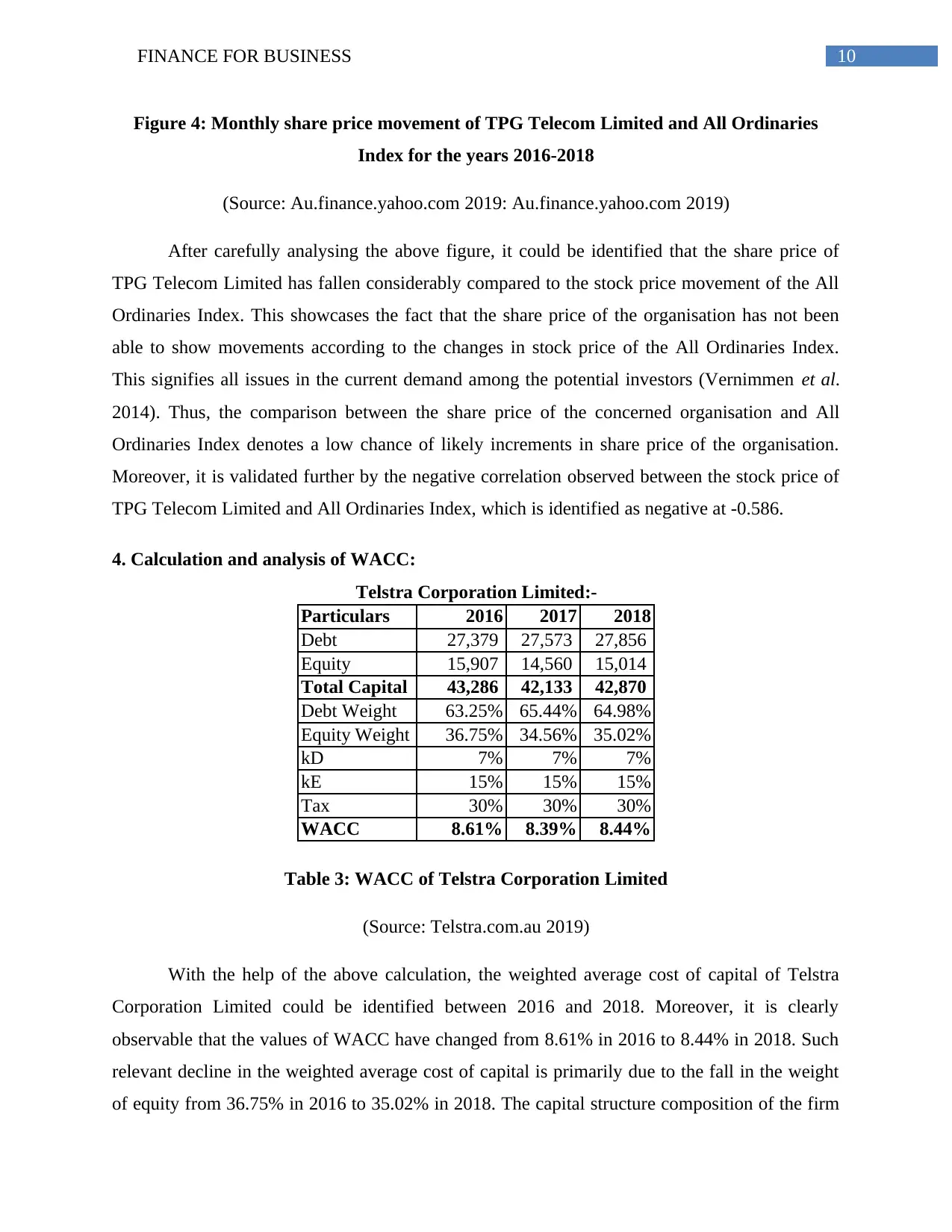
10FINANCE FOR BUSINESS
Figure 4: Monthly share price movement of TPG Telecom Limited and All Ordinaries
Index for the years 2016-2018
(Source: Au.finance.yahoo.com 2019: Au.finance.yahoo.com 2019)
After carefully analysing the above figure, it could be identified that the share price of
TPG Telecom Limited has fallen considerably compared to the stock price movement of the All
Ordinaries Index. This showcases the fact that the share price of the organisation has not been
able to show movements according to the changes in stock price of the All Ordinaries Index.
This signifies all issues in the current demand among the potential investors (Vernimmen et al.
2014). Thus, the comparison between the share price of the concerned organisation and All
Ordinaries Index denotes a low chance of likely increments in share price of the organisation.
Moreover, it is validated further by the negative correlation observed between the stock price of
TPG Telecom Limited and All Ordinaries Index, which is identified as negative at -0.586.
4. Calculation and analysis of WACC:
Particulars 2016 2017 2018
Debt 27,379 27,573 27,856
Equity 15,907 14,560 15,014
Total Capital 43,286 42,133 42,870
Debt Weight 63.25% 65.44% 64.98%
Equity Weight 36.75% 34.56% 35.02%
kD 7% 7% 7%
kE 15% 15% 15%
Tax 30% 30% 30%
WACC 8.61% 8.39% 8.44%
Telstra Corporation Limited:-
Table 3: WACC of Telstra Corporation Limited
(Source: Telstra.com.au 2019)
With the help of the above calculation, the weighted average cost of capital of Telstra
Corporation Limited could be identified between 2016 and 2018. Moreover, it is clearly
observable that the values of WACC have changed from 8.61% in 2016 to 8.44% in 2018. Such
relevant decline in the weighted average cost of capital is primarily due to the fall in the weight
of equity from 36.75% in 2016 to 35.02% in 2018. The capital structure composition of the firm
Figure 4: Monthly share price movement of TPG Telecom Limited and All Ordinaries
Index for the years 2016-2018
(Source: Au.finance.yahoo.com 2019: Au.finance.yahoo.com 2019)
After carefully analysing the above figure, it could be identified that the share price of
TPG Telecom Limited has fallen considerably compared to the stock price movement of the All
Ordinaries Index. This showcases the fact that the share price of the organisation has not been
able to show movements according to the changes in stock price of the All Ordinaries Index.
This signifies all issues in the current demand among the potential investors (Vernimmen et al.
2014). Thus, the comparison between the share price of the concerned organisation and All
Ordinaries Index denotes a low chance of likely increments in share price of the organisation.
Moreover, it is validated further by the negative correlation observed between the stock price of
TPG Telecom Limited and All Ordinaries Index, which is identified as negative at -0.586.
4. Calculation and analysis of WACC:
Particulars 2016 2017 2018
Debt 27,379 27,573 27,856
Equity 15,907 14,560 15,014
Total Capital 43,286 42,133 42,870
Debt Weight 63.25% 65.44% 64.98%
Equity Weight 36.75% 34.56% 35.02%
kD 7% 7% 7%
kE 15% 15% 15%
Tax 30% 30% 30%
WACC 8.61% 8.39% 8.44%
Telstra Corporation Limited:-
Table 3: WACC of Telstra Corporation Limited
(Source: Telstra.com.au 2019)
With the help of the above calculation, the weighted average cost of capital of Telstra
Corporation Limited could be identified between 2016 and 2018. Moreover, it is clearly
observable that the values of WACC have changed from 8.61% in 2016 to 8.44% in 2018. Such
relevant decline in the weighted average cost of capital is primarily due to the fall in the weight
of equity from 36.75% in 2016 to 35.02% in 2018. The capital structure composition of the firm
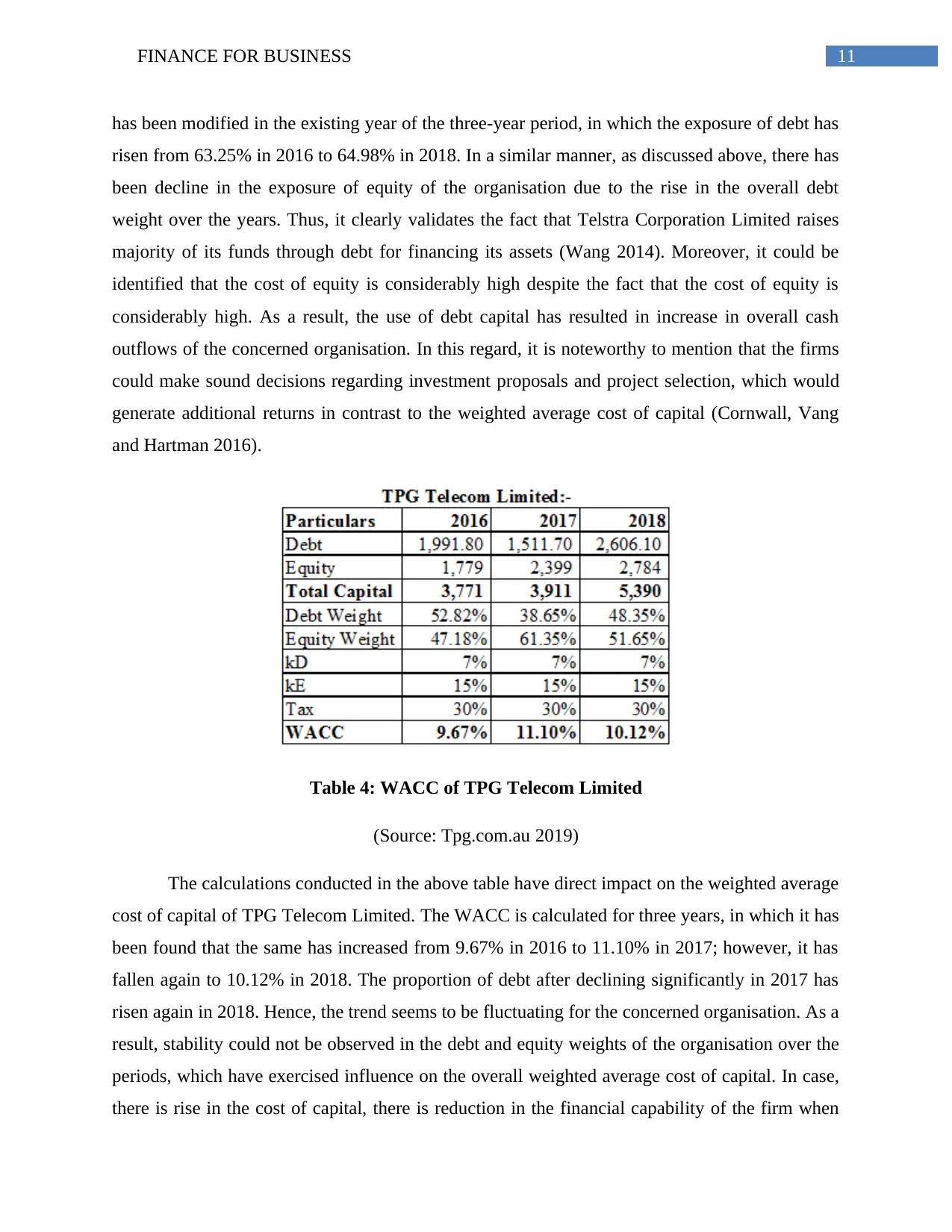
11FINANCE FOR BUSINESS
has been modified in the existing year of the three-year period, in which the exposure of debt has
risen from 63.25% in 2016 to 64.98% in 2018. In a similar manner, as discussed above, there has
been decline in the exposure of equity of the organisation due to the rise in the overall debt
weight over the years. Thus, it clearly validates the fact that Telstra Corporation Limited raises
majority of its funds through debt for financing its assets (Wang 2014). Moreover, it could be
identified that the cost of equity is considerably high despite the fact that the cost of equity is
considerably high. As a result, the use of debt capital has resulted in increase in overall cash
outflows of the concerned organisation. In this regard, it is noteworthy to mention that the firms
could make sound decisions regarding investment proposals and project selection, which would
generate additional returns in contrast to the weighted average cost of capital (Cornwall, Vang
and Hartman 2016).
Table 4: WACC of TPG Telecom Limited
(Source: Tpg.com.au 2019)
The calculations conducted in the above table have direct impact on the weighted average
cost of capital of TPG Telecom Limited. The WACC is calculated for three years, in which it has
been found that the same has increased from 9.67% in 2016 to 11.10% in 2017; however, it has
fallen again to 10.12% in 2018. The proportion of debt after declining significantly in 2017 has
risen again in 2018. Hence, the trend seems to be fluctuating for the concerned organisation. As a
result, stability could not be observed in the debt and equity weights of the organisation over the
periods, which have exercised influence on the overall weighted average cost of capital. In case,
there is rise in the cost of capital, there is reduction in the financial capability of the firm when
has been modified in the existing year of the three-year period, in which the exposure of debt has
risen from 63.25% in 2016 to 64.98% in 2018. In a similar manner, as discussed above, there has
been decline in the exposure of equity of the organisation due to the rise in the overall debt
weight over the years. Thus, it clearly validates the fact that Telstra Corporation Limited raises
majority of its funds through debt for financing its assets (Wang 2014). Moreover, it could be
identified that the cost of equity is considerably high despite the fact that the cost of equity is
considerably high. As a result, the use of debt capital has resulted in increase in overall cash
outflows of the concerned organisation. In this regard, it is noteworthy to mention that the firms
could make sound decisions regarding investment proposals and project selection, which would
generate additional returns in contrast to the weighted average cost of capital (Cornwall, Vang
and Hartman 2016).
Table 4: WACC of TPG Telecom Limited
(Source: Tpg.com.au 2019)
The calculations conducted in the above table have direct impact on the weighted average
cost of capital of TPG Telecom Limited. The WACC is calculated for three years, in which it has
been found that the same has increased from 9.67% in 2016 to 11.10% in 2017; however, it has
fallen again to 10.12% in 2018. The proportion of debt after declining significantly in 2017 has
risen again in 2018. Hence, the trend seems to be fluctuating for the concerned organisation. As a
result, stability could not be observed in the debt and equity weights of the organisation over the
periods, which have exercised influence on the overall weighted average cost of capital. In case,
there is rise in the cost of capital, there is reduction in the financial capability of the firm when
⊘ This is a preview!⊘
Do you want full access?
Subscribe today to unlock all pages.

Trusted by 1+ million students worldwide
1 out of 18
Related Documents
Your All-in-One AI-Powered Toolkit for Academic Success.
+13062052269
info@desklib.com
Available 24*7 on WhatsApp / Email
![[object Object]](/_next/static/media/star-bottom.7253800d.svg)
Unlock your academic potential
Copyright © 2020–2025 A2Z Services. All Rights Reserved. Developed and managed by ZUCOL.


